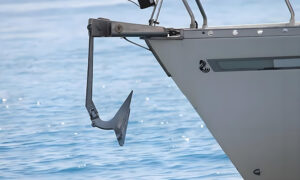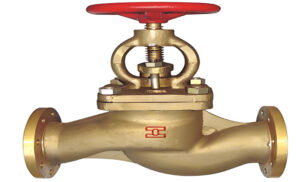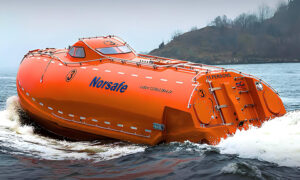Container lashing is the process of securing cargo within a shipping container. This is typically done using rope or webbing, which is threaded through anchor points on the walls of the container. The cargo is then tied down, so that it doesn’t shift during transport.
Container lashing is an important part of the shipping process, and helps to ensure that cargo arrives safely at its destination. There are many different techniques that can be used, and each has its own advantages and disadvantages.
What is container lashing?
Lashing is the process of securing cargo inside a container. This is done using lashing equipment, which can include ropes, wire, chains, and other materials. Lashing ensures that cargo is stable during transport and prevents it from shifting or moving around inside the container. It also helps to protect the cargo from damage.
The importance of container lashing
Container lashing is the process of securing cargo inside of a container using ropes, straps, or other materials. This is important because it helps to prevent the cargo from shifting during transport, which can damage the goods or cause them to become lost. It also helps to keep the container itself from becoming damaged or broken.
The benefits of container lashing
There are many benefits of container lashing, including preventing damage to your cargo, deterring theft, and reducing the overall cost of shipping. Container lashing is a process of securing your cargo in a container using ropes, cords, straps, or other materials. This ensures that your cargo stays in place during transit and doesn’t shift or fall over, which could cause damage.
In addition to preventing damage, lashing your containers can also help to deter theft. If thieves can’t see what’s inside of a container, they’re less likely to try to break into it. This can save you money on replacement costs and insurance claims.
Overall, container lashing is an important process that can save you time and money in the long run. Make sure to consult with your shipping company to see what their specific requirements are for lashing your cargo.
The different types of container lashing
There are four different types of container lashing:
– twistlock
– turnbuckle
– ratchet
– camlok
twistlock is the most common type of container lashing. It is a device that locks two bars together, preventing them from moving relative to each other. The bars are twisted together to lock them in place.
Turnbuckle is a device used to tighten or loosen a cord or rod. It consists of a rod with two threaded ends. One end is screwed into a stationary object, such as a wall or post. The other end is screwed into a fitting that can be moved, such as a hook or eyelet. By turning the rod, the tension in the cord or rod can be increased or decreased.
Ratchet is a device that prevents a rope or chain from being pulled back through it. It consists of a wheel with teeth, and a pawl (or ratchet) that engages the teeth. The ratchet can only move in one direction, so it prevents the rope from being pulled back through it. This type of container lashing is often used in combination with another type, such as twistlock, to provide additional security.
Camlok is a device used to secure two ropes or chains together. It consists of two cam-shaped plates that fit together to form a locking mechanism. The cams impede movement of the ropes or chains in one direction, but allow them to slide past each other in the other direction. This type of container lashing is often used in combination with another type, such as twistlock, to provide additional security
The steps involved in container lashing
In order to properly secure a container onto a vessel, there are several steps that must be followed in order to ensure a safe and secure voyage. The steps involved in container lashing are as follows:
1. The first step is to make sure that the vessel is properly prepared for lashing. This includes ensuring that the lashing points are in good condition and that the lashings themselves are of the proper length and thickness.
2. Once the vessel is prepared, the next step is to place the container onto the deck of the vessel.
3. The next step is to secure the container using lashings. These lashings must be placed around the container in such a way that they can support the weight of the container and keep it securely in place during transit.
4. After the lashings have been secured, the final step is to inspect the entire assembly to make sure that everything has been done properly and that there are no potential problems that could cause problems during transit.
The challenges associated with container lashing
The main challenges associated with container lashing are:
– Securing cargo in containers so that it does not shift during transport
– Maintaining the integrity of the structure of the container itself
In order to overcome these challenges, container lashing must be approached in a systematic and methodical manner. There are a number of factors that need to be taken into account, including the type of cargo being transported, the weight and size of the cargo, the route that the container will be taking, and the weather conditions that are likely to be encountered along the way.
By taking all of these factors into account, it is possible to devise a lashing plan that will ensure the safe and secure transport of your cargo.
The future of container lashing
Lashing is a method of securing cargo in a container. It is done by fastening ropes or wires to the corners of the container and then to the cargo, so that the cargo does not move during transport.
Lashing is important because it prevents damage to both the cargo and the container. If cargo is not secured properly, it can shift during transport and damage the container. This can lead to leaks, structural damage, and even personal injury.
Lashing is also important for safety reasons. If cargo shifts during transport, it can become unbalanced and topple over. This can cause serious accidents, especially if the container is carrying dangerous or poisonous material.
There are many different types of lashing methods, but all of them have one thing in common: they prevent cargo from moving during transport. The most common type of lashing is called ratchet lashing. This method uses a ratchet (a device that locks in place when tightened) to secure the lashings. Other types of lashings include webbing lashings and chain lashings.
Container lashing is a vital part of container shipping, and it is important to choose the right lashing method for your needs. If you are unsure about which lashing method to use, you can always ask for advice from a professional shipping company.
Container lashing case studies
No two container-lashing cases are alike. All have their own unique set of circumstances, including the type and number of containers being lashed, the condition of the containers, the cargo being transported, and the lashing requirements of the shipping line or port.
To get a better understanding of how our lashing system works, let’s take a look at two recent container-lashing case studies.
In the first case study, we were Transporting 20′ iso containers loaded with steel coils from point A to point B. The majority of the route was on paved roads, but there was a short section of unpaved road near the end. We used our ratchet lashings to secure the containers to the flatbed trailer, and we used Dunnage bags to prevent the coils from shifting during transit.
In the second case study, we were transporting 40′ high cube containers loaded with paper products from point A to point B. The entire route was on paved roads, but there were several sharp turns that we had to take into account when lashing down the containers. We used our tension lashing system to secure the containers to the trailer, and we used corner castings and block supports to keep them from shifting during transit.






